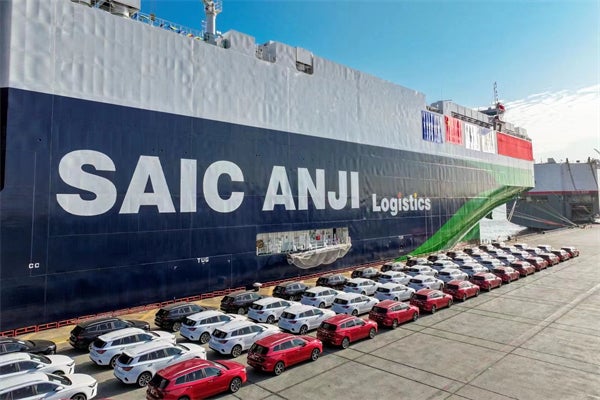Ford has cut the amount of energy used to make each vehicle 22% in the last six years with plans to reduce another 25% by 2016, the company said in a new report.
Decreased energy consumption is just one highlight of Ford’s thirteenth annual Sustainability Report – a comprehensive showcase of Ford’s efforts to tackle a myriad of sustainability challenges of a rapidly changing world. The report is titled, “Blueprint for Sustainability: Accelerating Ahead,” and can be found online.
Other successful initiatives featured include reductions in water use, waste-to-landfill and CO2 emissions; and improved fuel economy and safety.
“Sustainability has moved from the periphery to the centre of our strategy for succeeding in the marketplace and helping to address global challenges,” said Robert Brown, vice president, Sustainability, Environment and Safety Engineering.
This year’s report is the first one overseen by Brown – appointed to replace Sue Cischke following her retirement earlier this year. Brown has been with Ford since 1979 and most recently served as vice president, Sustainability, Environment, and Safety Engineering at Ford of Europe.
Ford issued its first sustainability report in 1999 to address the company’s initiatives regarding social, economic and environmental issues. Like Ford’s sustainability related processes and results, the report is evolving, too. New this year are sections highlighting Ford’s regional sustainability initiatives from places like Europe, South America and Asia; video commentary from Ford President and chief executive officer Alan Mulally; and commentary from third party subject matter experts like Nobel Peace Prize Winner Dr. Rajendra Pachauri.
How well do you really know your competitors?
Access the most comprehensive Company Profiles on the market, powered by GlobalData. Save hours of research. Gain competitive edge.

Thank you!
Your download email will arrive shortly
Not ready to buy yet? Download a free sample
We are confident about the unique quality of our Company Profiles. However, we want you to make the most beneficial decision for your business, so we offer a free sample that you can download by submitting the below form
By GlobalData“Our sustainability report is far from a bunch of tables and charts,” said John Viera, global director, Sustainability and Vehicle Environmental Matters. “Anyone who spends any amount of time with it will truly get a sense of just how committed Ford is to supporting positive change and reducing the environmental impact of its products and facilities.”
Ford of Europe announced its five year sustainable manufacturing strategies across water, landfill waste and emissions at the beginning of 2012. The ambitious targets would see the average Ford vehicle using 30% less water and creating 70% less waste-to-landfill during the production stage within the next five years.
Ford’s Cologne, Genk and Saarlouis plants are already waste-to-landfill free, with the remaining five manufacturing sites embarking on location-specific programmes to drastically reduce the four main waste areas of paint sludge, municipal wastes, grinding sludge and material filter material (which together total 80% of all waste) by as early as 2013. The aim is to reduce waste-to-landfill per vehicle from an average 5 kilograms to 1.5 kilograms.
The new water strategy is expected to see a 30% reduction in water use during production, the equivalent to 1,100 litres per vehicle, and could alone unlock savings of EUR2.3m (US$2.9m). The route to achieving this will be through continued metering and evaluation. This will contribute to Ford’s global target to reduce water use per vehicle from 9.5 cubic metres to 3.5 cubic metres by 2015 (Europe’s target is 5 cubic metres to 1.5 cubic metres).
Later in 2012, Ford of Europe will outline its strategy on energy use and purchasing. Performance highlights during 2011/12 include:
- Launched the first all-electric vehicle in Europe, the Transit Connect Electric.
- Launched the all-new 1.0 EcoBoost engine in the Focus, making the model Ford’s most fuel-efficient petrol car ever with CO2 emissions of 109 grams per kilometre.
- Euro NCAP, Europe’s leading authority on auto safety, named the Focus the “Best in Class” small family car. In addition, the new Ranger is the first pickup to receive the maximum 5 Star Euro NCAP rating.
- 800 employees contributed 16 hours of their time, which was funded by Ford, to a variety of community projects delivering social, cultural or ecological benefits.
Globally, Ford is targeting a drop in energy consumption of 25% between now and 2016. Each Ford facility utilises a comprehensive set of measured environmental targets to track and accelerate improvements designed with the environment in mind. The targets are reviewed and updated annually.
In addition to the drop in energy consumption, Ford also:
- Reduced CO2 emissions from global operations in 2011 by 8% on a per vehicle basis compared with 2010
- Turned what would have been 163 tons of waste paint into enough power for 55 residential homes for one year through just one of many new ways Ford is converting waste to energy
- Introduced advanced water-treatment technologies to allow the reuse of water and reduce water supply requirements, water discharges and use of treatment chemicals and the generation of solid waste
“Integration of our sustainability initiatives into the Ford Production System has enabled us to accelerate environmental improvements at our manufacturing facilities,” said Andy Hobbs, director, Environmental Quality Office. “This enables all members of the Ford manufacturing team to contribute to meeting our environmental targets.”
Ford vehicles are a major focal point of the company’s efforts to reduce environmental impact. For example, the seat fabric in most of Ford’s new or redesigned vehicles must now consist of at least 25% post-industrial or post-consumer recycled content. A total of 37 fabrics now meet the requirements and have been incorporated into Ford vehicles.
Because Ford affects such a broad range of stakeholders – employees, dealers, investors, communities – the sustainability report cannot ignore some of the ways Ford interacted with those parties in 2011, said David Berdish, manager, Social Sustainability.
For example, the report details how Ford revised it’s, “Code of Human Rights, Basic Working Conditions and Corporate Responsibility,” which applies to not only Ford itself, but its global supply chain. The code deals with subjects such as working hours and conditions, non-discrimination and other health, safety and environmental issues. Nearly 400 suppliers around the world were trained in 2011 through Ford-led and joint industry programs.
“Reporting our progress on human rights and stories of our projects in the sustainability report is our primary source of communication regarding issues of social sustainability – and not just to media and customers,” said Berdish. “Investors are paying attention to working conditions, conflict minerals and trafficking more intensely and our suppliers need to be kept up-to-speed on all developments.”







